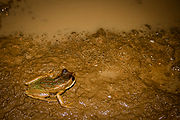
Gastrotheca
Encyclopedia
Gastrotheca is a genus
of frog
s (family
Hemiphractidae) found in Central
and South America
. Most species
occur in the American Cordillera
from southern Costa Rica
to northwestern Argentina
. This genus makes up the bulk of marsupial frog diversity; formerly it was placed in the "Leptodactylidae
" assemblage.
Marsupial frogs are so-called because they possess a dorsal brood pouch. In some species the eggs are fertilized on the female's lower back, and are inserted in her pouch with the aid of the male's toes. The eggs remain in contact with the female's vascular tissue
, which provides them oxygen. In other species the eggs are laid in damp leaf litter and the male guards them. When they begin to hatch it is not wet enough for the tadpole
s to survive so as many as possible (not generally all) are taken by the father into two pouches on his underside. They remain "inside" his pouch for several weeks until he "gives birth" to live frogs.
Gastrotheca guentheri
(Guenther's Marsupial Frog) is the only known frog with true teeth in its lower jaw. Gastrotheca riobambae (Andean Marsupial Tree Frog) is kept as pet and is used in in scientific experiments.


Genus
In biology, a genus is a low-level taxonomic rank used in the biological classification of living and fossil organisms, which is an example of definition by genus and differentia...
of frog
Frog
Frogs are amphibians in the order Anura , formerly referred to as Salientia . Most frogs are characterized by a short body, webbed digits , protruding eyes and the absence of a tail...
s (family
Family (biology)
In biological classification, family is* a taxonomic rank. Other well-known ranks are life, domain, kingdom, phylum, class, order, genus, and species, with family fitting between order and genus. As for the other well-known ranks, there is the option of an immediately lower rank, indicated by the...
Hemiphractidae) found in Central
Central America
Central America is the central geographic region of the Americas. It is the southernmost, isthmian portion of the North American continent, which connects with South America on the southeast. When considered part of the unified continental model, it is considered a subcontinent...
and South America
South America
South America is a continent situated in the Western Hemisphere, mostly in the Southern Hemisphere, with a relatively small portion in the Northern Hemisphere. The continent is also considered a subcontinent of the Americas. It is bordered on the west by the Pacific Ocean and on the north and east...
. Most species
Species
In biology, a species is one of the basic units of biological classification and a taxonomic rank. A species is often defined as a group of organisms capable of interbreeding and producing fertile offspring. While in many cases this definition is adequate, more precise or differing measures are...
occur in the American Cordillera
American cordillera
The American Cordillera is a cordillera that consists of an essentially continuous sequence of mountain ranges that form the western "backbone" of North America, Central America, South America and Antarctica. From north to south, this sequence of overlapping and parallel ranges begins with the...
from southern Costa Rica
Costa Rica
Costa Rica , officially the Republic of Costa Rica is a multilingual, multiethnic and multicultural country in Central America, bordered by Nicaragua to the north, Panama to the southeast, the Pacific Ocean to the west and the Caribbean Sea to the east....
to northwestern Argentina
Argentina
Argentina , officially the Argentine Republic , is the second largest country in South America by land area, after Brazil. It is constituted as a federation of 23 provinces and an autonomous city, Buenos Aires...
. This genus makes up the bulk of marsupial frog diversity; formerly it was placed in the "Leptodactylidae
Leptodactylidae
Leptodactylidae is a diverse family of frogs that probably diverged from other hyloids during the Cenozoic era, or possibly at the end of the Mesozoic. There are roughly 50 genera, one of which is Eleutherodactylus, the largest vertebrate genus, with over 700 species...
" assemblage.
Marsupial frogs are so-called because they possess a dorsal brood pouch. In some species the eggs are fertilized on the female's lower back, and are inserted in her pouch with the aid of the male's toes. The eggs remain in contact with the female's vascular tissue
Circulatory system
The circulatory system is an organ system that passes nutrients , gases, hormones, blood cells, etc...
, which provides them oxygen. In other species the eggs are laid in damp leaf litter and the male guards them. When they begin to hatch it is not wet enough for the tadpole
Tadpole
A tadpole or polliwog is the wholly aquatic larval stage in the life cycle of an amphibian, particularly that of a frog or toad.- Appellation :...
s to survive so as many as possible (not generally all) are taken by the father into two pouches on his underside. They remain "inside" his pouch for several weeks until he "gives birth" to live frogs.
Gastrotheca guentheri
Gastrotheca guentheri
Guenther's Marsupial Frog is a species of frog in the Hemiphractidae family.It is found in Colombia and Ecuador. Its natural habitats are subtropical or tropical moist lowland forests, subtropical or tropical moist montanes, and rivers. It is threatened by habitat loss.It is the only known frog...
(Guenther's Marsupial Frog) is the only known frog with true teeth in its lower jaw. Gastrotheca riobambae (Andean Marsupial Tree Frog) is kept as pet and is used in in scientific experiments.
Species



